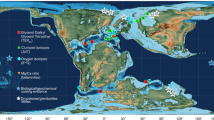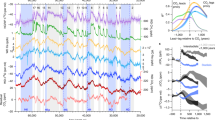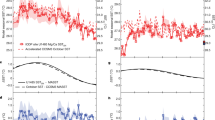Abstract
Atmospheric carbon dioxide concentrations seem to have been several times modern levels during much of the Palaeozoic era (543–248 million years ago), but decreased during the Carboniferous period to concentrations similar to that of today1,2,3. Given that carbon dioxide is a greenhouse gas, it has been proposed that surface temperatures were significantly higher during the earlier portions of the Palaeozoic era1. A reconstruction of tropical sea surface temperatures based on the δ18O of carbonate fossils indicates, however, that the magnitude of temperature variability throughout this period was small4, suggesting that global climate may be independent of variations in atmospheric carbon dioxide concentration. Here we present estimates of sea surface temperatures that were obtained from fossil brachiopod and mollusc shells using the ‘carbonate clumped isotope’ method5—an approach that, unlike the δ18O method, does not require independent estimates of the isotopic composition of the Palaeozoic ocean. Our results indicate that tropical sea surface temperatures were significantly higher than today during the Early Silurian period (443–423 Myr ago), when carbon dioxide concentrations are thought to have been relatively high, and were broadly similar to today during the Late Carboniferous period (314–300 Myr ago), when carbon dioxide concentrations are thought to have been similar to the present-day value. Our results are consistent with the proposal that increased atmospheric carbon dioxide concentrations drive or amplify increased global temperatures1,6.
This is a preview of subscription content, access via your institution
Access options
Subscribe to this journal
Receive 51 print issues and online access
$199.00 per year
only $3.90 per issue
Buy this article
- Purchase on Springer Link
- Instant access to full article PDF
Prices may be subject to local taxes which are calculated during checkout



Similar content being viewed by others
References
Berner, R. A. GEOCARBII: A revised model of atmospheric CO2 over Phanerozoic time. Am. J. Sci. 294, 56–91 (1994)
Berner, R. A. & Kothavala, Z. GEOCARBIII: A revised model of atmospheric CO2 over Phanerozoic time. Am. J. Sci. 301, 182–204 (2001)
François, L. M. & Walker, J. C. G. Modelling the Phanerozoic carbon cycle and climate: Constraints from the 87Sr/86Sr isotopic signature of seawater. Am. J. Sci. 292, 81–135 (1992)
Veizer, J., Godderis, Y. & François, L. M. Evidence for decoupling of atmospheric CO2 and global climate during the Phanerozoic eon. Nature 408, 698–701 (2000)
Ghosh, P. et al. 13C–18O bonds in carbonate minerals: A new kind of paleothermometer. Geochim. Cosmochim. Acta 70, 1439–1456 (2006)
Royer, D. L., Berner, R. A. & Park, J. Climate sensitivity constrained by CO2 concentrations over the past 420 million years. Nature 446, 530–532 (2007)
Ruddiman, W. F. Earth’s Climate: Past and Future (Freeman, New York, 2001)
Montañez, I. P. et al. CO2-forced climate and vegetation instability during Late Paleozoic deglaciation. Science 315, 87–91 (2007)
Mora, C. I., Driese, S. G. & Colarusso, L. A. Middle to late Paleozoic atmospheric CO2 levels from soil carbonate and organic matter. Science 271, 1105–1107 (1996)
Yapp, C. J. & Poths, H. Ancient atmospheric CO2 pressures inferred from natural goethites. Nature 355, 342–344 (1992)
Crowley, T. J. & North, G. R. Paleoclimatology (Oxford Univ. Press, Oxford, 1991)
Caputo, M. V. & Crowell, J. C. Migration of glacial centers across Gondwana during Paleozoic Era. Geol. Soc. Am. Bull. 96, 1020–1036 (1985)
Frakes, L. A. & Francis, J. E. A guide to Phanerozoic cold polar climates from high-latitude ice-rafting in the Cretaceous. Nature 333, 547–549 (1988)
Boucot, A. J., Xu, C. & Scotese, C. R. Phanerozoic climate zones and paleogeography with a consideration of atmospheric CO2 levels. Paleont J. 38, 115–122 (2004)
Veizer, J. et al. 87Sr/86Sr, δ13C and δ18O evolution of Phanerozoic seawater. Chem. Geol. 161, 59–88 (1999)
Land, L. S. Comment on “Oxygen and carbon isotopic composition of Ordovician brachiopods: Implications for coeval seawater” by H. Qing and J. Veizer. Geochim. Cosmochim. Acta 59, 2843–2844 (1995)
Azmy, K., Veizer, J., Bassett, M. G. & Copper, P. Oxygen and carbon isotopic composition of Silurian brachiopods: Implications for coeval seawater and glaciations. Geol. Soc. Am. Bull. 110, 1499–1512 (1998)
Azmy, K., Veizer, J., Jin, J., Copper, P. & Brand, U. Paleobathymetry of a Silurian shelf based on brachiopod assemblages: An oxygen isotope test. Can. J. Earth Sci. 43, 281–293 (2006)
Squires, R. L. Burial Environment, Diagenesis, Mineralogy and Mg & Sr Contents of Skeletal Carbonates in the Buckhorn Asphalt of Middle Pennsylvanian Age, Arbuckle Mountains, Oklahoma. PhD thesis, California Inst. Technol. (1973)
Brand, U. The oxygen and carbon isotopic composition of Carboniferous fossil components: Sea-water effects. Sedimentology 29, 139–147 (1982)
Brand, U. Aragonite-calcite transformation based on Pennsylvanian molluscs. Geol. Soc. Am. Bull. 101, 377–390 (1989)
Wenzel, B., Lécuyer, C. & Joachimski, M. M. Comparing oxygen isotope records of Silurian calcite and phosphate—δ18O compositions of brachiopods and conodonts. Geochim. Cosmochim. Acta 64, 1859–1872 (2000)
Gregory, R. T. & Taylor, H. P. An oxygen isotope profile in a section of Cretaceous oceanic crust, Samail ophiolite, Oman – Evidence for δ18O buffering of the oceans by deep (less than 5 km) seawater-hydrothermal circulation at mid-ocean ridges. J. Geophys. Res. 86, 2737–2755 (1981)
Muehlenbachs, K. The oxygen isotopic composition of the oceans, sediments and the seafloor. Chem. Geol. 145, 263–273 (1998)
Kasting, J. F. et al. Paleoclimates, ocean depth, and the oxygen isotopic composition of seawater. Earth Planet. Sci. Lett. 252, 82–93 (2006)
Brock, T. D. Life at high temperatures. Science 230, 132–138 (1985)
Eiler, J. M. & Schauble, E. 18O13C16O in Earth’s atmosphere. Geochim. Cosmochim. Acta 68, 4767–4777 (2004)
Wallmann, K. Impact of atmospheric CO2 and galactic cosmic radiation on Phanerozoic climate change and the marine δ18O record. Geochem. Geophys. Geosys. 5, Q06004 10.1029/2003GC000683. (2004)
Wang, Z., Schauble, E. A. & Eiler, J. M. Equilibrium thermodynamics of multiply substituted isotopologues of molecular gases. Geochim. Cosmochim. Acta 68, 4779–4797 (2004)
McCrea, J. M. On the isotopic chemistry of carbonates and a paleotemperature scale. J. Chem. Phys. 18, 849–857 (1950)
Swart, P. K., Burns, S. J. & Leder, J. J. Fractionation of the stable isotopes of oxygen and carbon in carbon dioxide during the reaction of calcite with phosphoric acid as a function of temperature and technique. Chem. Geol. 86, 89–96 (1991)
Kim, S.-T. & O’Neil, J. R. Equilibrium and nonequilibrium oxygen isotope effects in synthetic carbonates. Geochim. Cosmochim. Acta 61, 3461–3475 (1997)
Böhm, F. E. et al. Oxygen isotope fractionation in marine aragonite of coralline sponges. Geochim. Cosmochim. Acta 64, 1695–1703 (2000)
Adkins, J. F., Boyle, E. A., Curry, W. B. & Lutringer, A. Stable isotopes in deep sea corals and a new mechanism for ‘‘vital effect’’. Geochim. Cosmochim. Acta 67, 1129–1143 (2003)
Ghosh, P., Eiler, J. M., Campana, S. E. & Feeney, R. F. Calibration of the carbonate ‘clumped isotope’ paleothermometer for otoliths. Geochim. Cosmochim. Acta 71, 2736–2744 (2007)
Brand, U., Logan, A., Hiller, N. & Richardson, J. Geochemistry of modern brachiopods: Applications and implications for oceanography and paleoceanography. Chem. Geol. 198, 305–334 (2003)
Wanamaker, A. D. et al. An aquaculture-based method for calibrated bivalve isotope paleothermometry. Geochem. Geophys. Geosyst. 7 Q09011 doi: 10.1029/2005GC001189 (2006)
Acknowledgements
We thank H. Affek, W. Guo and P. Ghosh for laboratory advice, and A. Wanamaker for assistance with samples.
Author information
Authors and Affiliations
Corresponding author
Ethics declarations
Competing interests
Reprints and permissions information is available at www.nature.com/reprints. The authors declare no competing financial interests.
Supplementary information
Supplementary Information
The file contains Supplementary Notes, Supplementary Figure S1, Supplementary Tables S1-S2 and additional references. (PDF 351 kb)
Rights and permissions
About this article
Cite this article
Came, R., Eiler, J., Veizer, J. et al. Coupling of surface temperatures and atmospheric CO2 concentrations during the Palaeozoic era. Nature 449, 198–201 (2007). https://doi.org/10.1038/nature06085
Received:
Accepted:
Published:
Issue Date:
DOI: https://doi.org/10.1038/nature06085
This article is cited by
-
A global synthesis of high-resolution stable isotope data from benthic foraminifera of the last deglaciation
Scientific Data (2023)
-
Skeletal–cement–microbial reefs in the Pennsylvanian: a case study in Guizhou, South China
International Journal of Earth Sciences (2023)
-
The PhanSST global database of Phanerozoic sea surface temperature proxy data
Scientific Data (2022)
-
Seawater Temperature and Dissolved Oxygen over the Past 500 Million Years
Journal of Earth Science (2019)
-
Assessing kinetic fractionation in brachiopod calcite using clumped isotopes
Scientific Reports (2018)
Comments
By submitting a comment you agree to abide by our Terms and Community Guidelines. If you find something abusive or that does not comply with our terms or guidelines please flag it as inappropriate.



